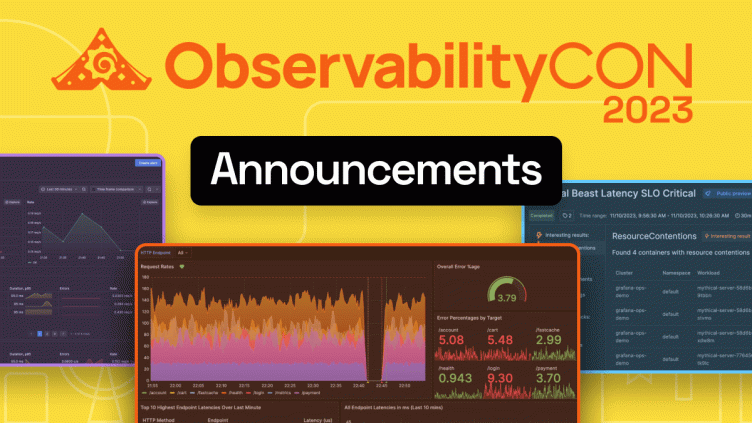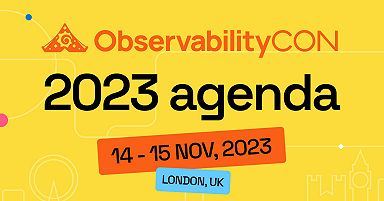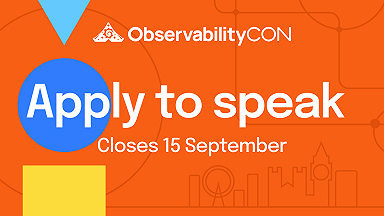
ObservabilityCON 2023: Major news announcements, product releases, and more!
During the opening keynote of ObservabilityCON 2023 in London, we announced a range of new updates to make it easier and faster for the open source observability community to get started and scale their observability stacks.
"Over the past two years, the biggest needs we’ve heard from our customers have been to make it easier to understand their observability data, to extend observability into the application layer, and to get deeper, contextualized analytics,” said Tom Wilkie, CTO of Grafana Labs.
One way we are working towards solving these issues is through the acquisition of Asserts.ai, whose technology will help Grafana Cloud users better understand their observability data and find issues more quickly, from the infrastructure to the application layer.
We also announced the general availability of Application Observability, an out-of-the box solution in Grafana Cloud that allows you to monitor applications and minimize MTTR (mean time to resolution).
“The GA of our Application Observability solution in Grafana Cloud, plus the Asserts acquisition, are big steps toward meeting those customer needs and providing an easier-to-use, integrated, and opinionated user experience,” said Wilkie.
Grafana Labs is also rolling out enhancements across Grafana Cloud as well as releasing Grafana Beyla 1.0, the open source eBPF-based application auto-instrumentation project that is now generally available for users to get started with application observability faster. Check out all the announcements from the ObservabilityCON 2023 opening keynote and sign up to learn when all of the ObservabilityCON sessions are available on demand.
Correlate observability data with Asserts
We are thrilled to welcome Asserts.ai into the Grafana Labs family. Asserts is a startup built to provide an easier way of exploring your telemetry and derive new insights for more efficient root cause analysis and faster issue resolution. The company was founded in 2020 by Manoj Acharya, who was the fifth engineer hired at AppDynamics to build that product from the ground up.
Asserts serves as a contextual layer for Prometheus metrics and provides out-of-the-box insights into the relationships among various system components over time (for example, what application is running in which pod, node, namespace, etc.) to enable users to better understand and navigate their applications and infrastructure. This layer is also used to build sophisticated, easy-to-use experiences for troubleshooting alerts, querying data, and automatic baselining.
At Heka.ai, “Asserts helps us quickly correlate problems in the cluster and surfaces previously unknown, lingering issues,” says Gabriel Creti, Engineering Manager and Technical Lead. “Asserts also offloads toil from our operations teams. By providing pre-made alerting rules and dashboards, it streamlines the painful job of maintaining them. It has always been a plus that the Asserts UI embeds directly into Grafana. We are excited to see it become a native part of the LGTM (Loki, Grafana, Tempo, Mimir) Stack going forward.”
Read more about the future of Grafana Labs and Asserts in our blog post and watch a demo of Asserts in action.
Application observability with Grafana Cloud
Grafana Cloud Application Observability – which is generally available to all users of Grafana Cloud, including the forever-free tier – provides SREs and developers an out-of-the-box experience to accelerate root cause analysis and minimize mean time to resolution (MTTR). With its native support for both OpenTelemetry and Prometheus, Application Observability helps organizations looking to avoid vendor lock-in.
Read more about Application Observability in our blog post and watch a demo in the ObservabilityCON session “Unify your application and infrastructure observability” on demand.
eBPF-based auto-instrumentation with Grafana Beyla
To help users get started with application observability faster, Grafana Labs launched the open source project Grafana Beyla, which is now GA with the release of Grafana Beyla 1.0. Often, instrumenting an application for observability requires adding a language agent to the deployment or package, manually adding tracepoints, and then redeploying. By deploying Beyla as a DaemonSet in Kubernetes, you can instrument all your services with a single command, without modifying source code.
Based on eBPF, which allows you to attach your own programs to different points of the Linux kernel, Beyla auto-instruments HTTP/gRPC applications written in Go, C/C++, Rust, Python, Ruby, Java, NodeJS, .NET, and more. It provides vendor-agnostic Rate-Errors-Duration (RED) metrics and traces, exported in the OpenTelemetry format and as native Prometheus metrics.
Learn more about the latest features in Grafana Beyla 1.0 in our blog post and on our website. You can also join the Beyla community on GitHub.
Create and manage service level objectives with Grafana SLO
The interest and demand for SLOs continue to increase – according to Grafana Labs’ 2023 Observability Survey, more than half of respondents say they are using SLOs or moving in that direction. Grafana SLO makes it easy to create, manage, and scale service level objectives, SLO dashboards, and error budget alerts in Grafana Cloud, enabling users to monitor the services that have the most impact on their customers’ experience and ensure they stay healthy. The GA of Grafana SLO supports teams using as-code provisioning, via API or Terraform, and handles all of the cascading recording rules, eliminating manual query management.
Learn more by reading our Grafana SLO documentation or watching the ObservabilityCON 2023 session “Prioritize critical resources with SLO-driven IRM” on demand.
New Grafana Cloud cost management tools
Also at ObservabilityCON 2023, we introduced a new centralized cost management hub in Grafana Cloud with a suite of cost management tools that make it easier for Grafana Cloud administrators to manage, control, and optimize their spend.
The suite of tools, developed in direct response to customer feedback, introduces two new features — Log Volume Explorer, for investigating the source of high log volumes, and Usage Attribution Report, for analyzing monthly metrics usage by teams. Both features are available in public preview across all tiers of Grafana Cloud.
Also included in the suite is Adaptive Metrics, now generally available for all tiers of Grafana Cloud, with a new interactive UI to apply and remove recommendations for aggregating unused and partially used metrics into lower cardinality versions of themselves to reduce costs.
To learn more, read our Grafana Cloud cost management blog post.
AI/ML features for Grafana OSS and Grafana Cloud
Sticking to our “big tent,” open source approach to observability, Grafana Labs has released an open source LLM app (public preview) to enable large language model-based extensions to Grafana. This allows developers to leverage public data sets, connect their own LLM and vector databases, and build LLM-powered experiences in Grafana faster and better together as a community.
Additionally, AI/ML is being leveraged in feature development across Grafana Labs, prioritizing ways to help admins and developers remove toil and solve problems. New developments include:
- Sift, a powerful diagnostic assistant in Grafana Cloud designed to automatically discover contributing causes to incidents across metric, log, and tracing data
- Grafana Incident auto-summary, a tool that summarizes the key details from your incident timelines with a single click
- Generative AI features that help create dashboard metadata and simplify writing PromQL queries.
For more, watch the ObservabilityCON session “AI/ML + open source observability” on demand.
For all the latest updates from ObservabilityCON 2023, follow Grafana Labs on Twitter and LinkedIn or join the Grafana Labs Community Slack.



